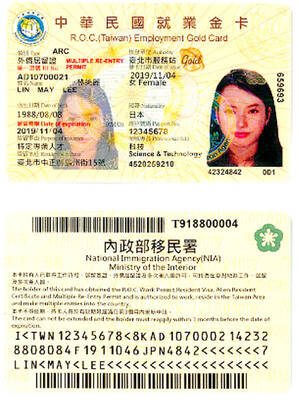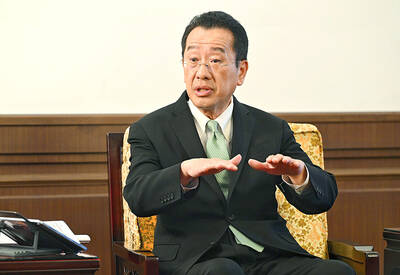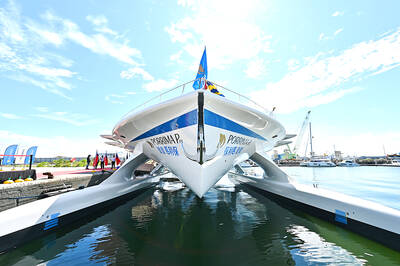Kentaro Tohyama is proud of his new iPhone. He stood in line overnight to get it when the device became available in Japan for the first time. But the 29-year-old computer engineer isn't about to part with his made-in-Japan cellphone either.
That kind of cautious response to last Friday’s arrival of Apple Inc’s phone appears common in Japan.
The iPhone was welcomed here with long lines of gadget fans. But it’s also being seen as shockingly alien to this nation’s quirky and closed mobile world, somewhat like the 19th century “black ships” of US Commodore Matthew Perry that forced an isolationist Japan to open to the West.
Japan’s cloistered mobile system has its own icons for e-mail and other unique tools. That means many people, even iPhone fans like Tohyama, are likely to stick to their old-style phones lest they be left out of familiar communication circles.
“I don’t want my friends to think I’m this uncool, cold-hearted person,” Tohyama said.
For example, young people in Japan take for granted the ability to share phone numbers, e-mail addresses and other contact information by beaming it from one phone to another over infrared connections. Being without those instantaneous exchanges would be the death knell on the Japanese dating circuit.
While the iPhone has Bluetooth wireless links, it has no infrared connection.
The iPhone lacks other technology long available on Japanese cellphones, such as digital TV broadcasts, a built-in camcorder, voice recognition and an “electronic wallet” function.
Japanese customers also might struggle with the fact that using the iPhone requires both hands. The Japanese style of texting relies mainly on a thumb — so much so that experienced users are dubbed oyayubi zoku or “thumb tribe.”
Also missing from Steve Jobs’ much-praised design: a hole in the handset for hanging trinkets. Westerners may scoff at them as childish, but having them is a common social practice in Japan.
For all these reasons, analysts say it’s unclear whether the iPhone will catch on with the masses in Japan or end up a fad with the computer-savvy niche.
Sales so far in Japan are hard to discern. Apple said it sold 1 million iPhones in the first three days its newest model was on the market, but the company offered no regional breakdown.
Softbank Corp, the Japanese carrier of the iPhone, said it sold out of the devices on the first day. But it did not reveal how many had been available. One clue comes from GfK Marketing Services Japan Ltd, which said Softbank sold half of all mobile phones in Japan that day, up from a typical 19 percent.
Many Japanese buyers were curious about the iPhone’s sleek design. And some acknowledged that the device might show the Japanese market some new tricks.
Tohyama’s eyes were opened by the iPhone’s quick access to the Internet. Some Japanese cellphones show Web pages, but access on even the latest models is slower than on the iPhone. Most Japanese phones don’t present as colorful a picture as the iPhone does.
Other new iPhone owners had more basic concerns.
“I wish the battery life were better,” said Shunji Hagii, 37.

GAINING STEAM: The scheme initially failed to gather much attention, with only 188 cards issued in its first year, but gained popularity amid the COVID-19 pandemic Applications for the Employment Gold Card have increased in the past few years, with the card having been issued to a total of 13,191 people from 101 countries since its introduction in 2018, the National Development Council (NDC) said yesterday. Those who have received the card have included celebrities, such as former NBA star Dwight Howard and Australian-South Korean cheerleader Dahye Lee, the NDC said. The four-in-one Employment Gold Card combines a work permit, resident visa, Alien Resident Certificate (ARC) and re-entry permit. It was first introduced in February 2018 through the Act Governing Recruitment and Employment of Foreign Professionals (外國專業人才延攬及雇用法),

CAUTION URGED: Xiaohongshu and Douyin — the Chinese version of TikTok — are tools the Chinese government uses for its ‘united front’ propaganda, the MAC said Mainland Affairs Council (MAC) Minister Chiu Chui-cheng (邱垂正) yesterday urged people who use Chinese social media platforms to be cautious of being influenced by Beijing’s “united front” propaganda and undermining Taiwan’s sovereignty. Chiu made the remarks in response to queries about Chinese academic Zhang Weiwei (張維為) saying that as young Taiwanese are fond of interacting on Chinese app Xiaohongshu (小紅書, known as RedNote in English), “after unification with China, it would be easier to govern Taiwan than Hong Kong.” Zhang is professor of international relations at Shanghai’s Fudan University and director of its China Institute. When giving a speech at China’s Wuhan

ENHANCE DETERRENCE: Taiwan has to display ‘fierce resolve’ to defend itself for China to understand that the costs of war outweigh potential gains, Koo said Taiwan’s armed forces must reach a high level of combat readiness by 2027 to effectively deter a potential Chinese invasion, Minister of National Defense Wellington Koo (顧立雄) said in an interview with the Chinese-language Liberty Times (sister newspaper of the Taipei Times) published yesterday. His comments came three days after US Secretary of State Marco Rubio told the US Senate that deterring a Chinese attack on Taiwan requires making a conflict “cost more than what it’s worth.” Rubio made the remarks in response to a question about US policy on Taiwan’s defense from Republican Senator John Cornyn, who said that Chinese

The zero emissions ship Porrima P111 was launched yesterday in Kaohsiung, showcasing the nation’s advancement in green technology, city Mayor Chen Chi-mai (陳其邁) said. The nation last year acquired the Swiss-owned vessel, formerly known as Turanor PlanetSolar, in a bid to boost Taiwan’s technology sector, as well as ecotourism in Palau, Chen said at the ship’s launch ceremony at Singda Harbor. Palauan President Surangel Whipps Jr and Minister of Foreign Affairs Lin Chia-lung (林佳龍) also attended the event. The original vessel was the first solar-powered ship to circumnavigate the globe in a voyage from 2010 to 2012. Taiwan-based Porrima Inc (保利馬) installed upgrades with